The entertainment industry is undergoing a dramatic evolution, driven by the rise of immersive technologies like virtual reality (VR) and augmented reality (AR). What was once the stuff of science fiction is now becoming part of everyday life, transforming how we play, watch, and interact with media. From video games and movies to concerts and theme parks, VR and AR are reshaping the boundaries of storytelling and user engagement.
Virtual reality creates a fully digital environment that users can explore through headsets and motion-tracking systems. By placing users inside a computer-generated world, VR allows for complete immersion, where sight, sound, and even touch are simulated. In gaming, this means players are no longer just controlling characters—they are stepping into the game itself. Titles like Beat Saber, Half-Life: Alyx, and Resident Evil Village VR provide players with first-person experiences that are deeply engaging, intense, and physically interactive.Visit Online https://hackerinside.cn for More details.
Beyond gaming, VR is finding a place in cinematic storytelling. Filmmakers and content creators are experimenting with 360-degree videos and interactive films that allow viewers to choose different perspectives or paths. This level of immersion creates a personal connection with the narrative, giving audiences a sense of presence and agency rarely found in traditional formats. Virtual concerts, such as those hosted on platforms like Wave or within virtual worlds like Fortnite, have redefined live entertainment, enabling fans to experience performances in unique, interactive settings regardless of location.
While VR immerses users in a fully virtual world, augmented reality overlays digital content onto the real world, enhancing it rather than replacing it. AR is already widely used in mobile apps, such as Pokémon GO and Snapchat filters, where digital objects or effects appear in the user’s environment through a smartphone or tablet camera. As AR technology becomes more advanced, it’s being integrated into glasses and headsets, bringing more natural, hands-free experiences.
AR is revolutionizing the way people consume live events and sports. Fans can receive real-time stats, player profiles, and visual effects layered over the field through AR-enabled devices. In museums and galleries, AR apps offer deeper engagement by animating exhibits or delivering interactive guides. The advertising and fashion industries are also leveraging AR to allow consumers to try products virtually, creating personalized and engaging shopping experiences.
One of the most promising aspects of immersive tech is its ability to foster social connection in digital spaces. Virtual reality platforms like VRChat, Meta Horizon Worlds, and Rec Room provide shared environments where users can interact through avatars, play games, attend events, or just hang out. These social VR spaces are becoming increasingly popular as alternatives to traditional social media, offering a sense of presence and interaction that feels more authentic and human.
As hardware becomes more accessible and software continues to advance, the impact of VR and AR on entertainment will only grow. Developers are creating more user-friendly tools for building immersive content, while companies are investing heavily in expanding infrastructure and content libraries. The convergence of AI with immersive tech is also opening new possibilities, enabling smarter, more responsive environments and virtual characters that can adapt to users’ behaviors and preferences.
Despite these advances, there are still challenges to overcome. VR headsets can be expensive and bulky, and motion sickness remains an issue for some users. Content creators must also consider ethical questions around user immersion, data privacy, and the psychological effects of highly realistic digital environments. However, as technology matures and adoption widens, these hurdles are being addressed with better design, user testing, and safety protocols.
In conclusion, the journey from VR to AR marks a shift toward more personalized, engaging, and interactive entertainment experiences. Immersive tech is not just changing how we consume media—it’s redefining the very nature of storytelling and audience participation. Whether exploring fantastical worlds in VR or enhancing real-life moments with AR, users are now at the center of the action, shaping the future of entertainment in ways never before imagined.

